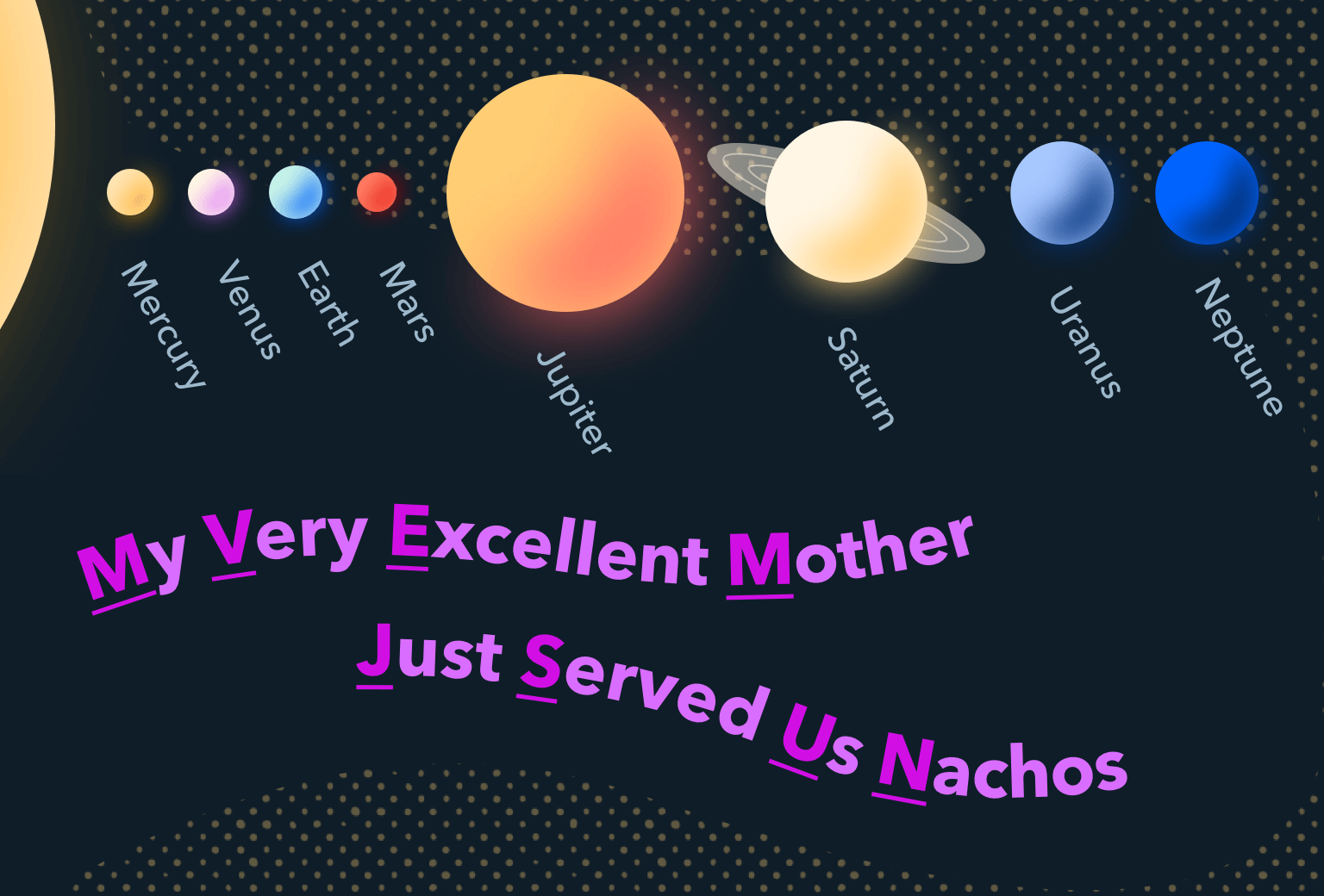Do you remember learning the phrase “Please Excuse My Dear Aunt Sally” in grade school? If so, you’re already familiar with mnemonic devices–tools to help remember important facts and principles.
What’s a mnemonic device?
Mnemonic devices use patterns to help with memory retrieval. Often, they are phrases or word groupings that rarely have anything to do with the intended memory topic.
In the example above, the mnemonic is used to help recall the mathematical order of operations for solving expressions. PEMDAS stands for Parentheses, Exponents, Multiplication, Division, Addition, and Subtraction.
While the words chosen are usually unrelated to the topic to be memorized, the nonsensical wording can make it more memorable.
Here’s some more examples you may be familiar with.
”Dear King Phillip Came Over For Good Soup” is used to remember the order of taxonomy: Kingdom, Phylum, Class, Order, Family, Genus, Species.
“My Very Excellent Mother Just Served Us Nachos” is used to remember the planets in our solar system: Mercury, Venus, Earth, Mars, Jupiter, Saturn, Uranus, Neptune. Sorry, Pluto…no mnemonics for you.

The science behind mnemonics
A 1967 study by Gerald R. Miller found that mnemonics increased recall and subsequently test scores by 77%! His experiment was to discover whether or not high school freshmen students who did not use mnemonics could benefit from the use of mnemonics.
Any type of mnemonic device supplied by the experimenter was found to be more effective in raising test grades than compared to the student constructing their own mnemonic. The study also found that the use of mnemonics may decrease in effectiveness as the amount of mnemonics used by any one student increases.
Types of mnemonic strategies
Depending on how you categorize them, there are several types of mnemonic strategies. Here are three common ones:
1. First letter
Just like the examples above, the first letter strategy uses the first letter of a series of words (either random or not) as a memory device to remember crucial information. There’s a one-to-one relationship between the words and letter series it helps you remember.
2. Pegword
This method works well for numbers and things in a sequence. It typically associates a number with a rhyming word, then links that word to the thing you’re trying to remember. An often-used pairing is one = sun, two = shoe, three= tree, etc. A common example is using pegwords to remember the order of our planets. 1 = Sun so one could associate the sun with a mercury thermometer. The process goes from associating 1 with sun, which equates to a mercury thermometer that links the association to mercury – our first planet.
3. Keyword
Keywords work by relating a new word that sounds similar to the chosen word and visual image to go along with it. An example Ester Heerema uses is pasta to help remember the Spanish word for grass, pasto. She imagines pasta noodles growing out of the ground. The similarity of the word pasta to pasto plus the visualization helps her mind retrieve the meaning.
How to make your own mnemonic device
Certification tests are timed and require quick and accurate recall of large quantities of information. If you want to make memorization easier, retain information long-term, and raise your exam score, here’s a step-by-step guide on creating your very own mnemonics using the first letter method.
-
- Step One: In order, write a vertical list of the words that you need to memorize.
- Step Two: Choose corresponding words or names to go along with each word. Using names of people you know and creating a funny scenario is often helpful for easy recall.
- Step Three: Once you finalize your sentence, make sure you can remember it. We suggest writing it out a few times or rehearsing it in your head in a catchy sing-song voice.
- Step Four: The next day, write out your vertical list again and see if you can remember your mnemonic. If you can’t, we suggest tweaking it slightly until you can recall it and put it to use.
While mnemonic devices can help everyone with tricky things to remember, they have often proven especially useful for students with learning disabilities. There’s also some research around how mnemonics can help people with degenerative brain diseases like Alzheimer’s.


 learning science
learning science